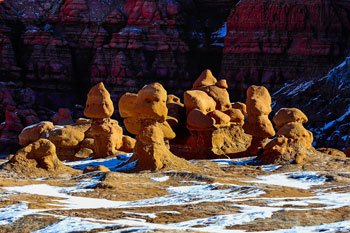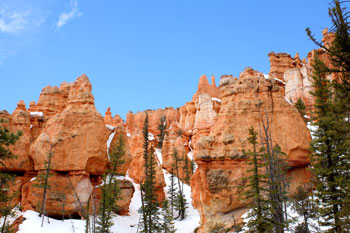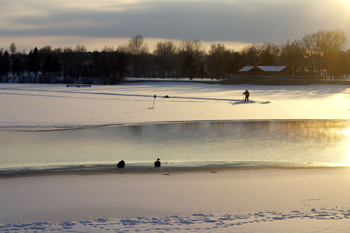This article may include affiliate links. If you click a link and make a purchase, Utah Outdoor Activities may receive a small commission at no extra cost to you. We only recommend products or services we personally use. FTC Affiliate Disclosure.

Utah has five national parks and 46 state parks. And while many of us think of summer as the primetime to visit them, winter offers lots of unique benefits. For starters, the crowds thin out when the cold weather hits. In fact, they sometimes even vanish completely. Imagine that—a trip into Utah’s gorgeous wilderness without RVs swarming around you.
So whether you want to hike at Capitol Reef, fish at Bear Lake, snowshoe at Scofield, or explore Canyonlands, this is the time to get off the couch and make some memories. Winter will give you a totally different perspective of Utah’s parks.
Here are five reasons that cold weather visits to Utah’s parks are amazing:
1. Snow accentuates the beauty
To the uninitiated, it might seem that snow could have a negative effect on the beauty of Utah’s parks. They might think intricacies of nature would simply be covered in a blanket of snow. This couldn’t be further from the truth.
Perhaps the best example of snow adding to the beauty can be found at Bryce Canyon National Park. The colorful rock formations are stunning during the summer months, but once they’re contrasted with white accents of snow, they become more vibrant than ever.
The snow also provides a unique pathway as you traverse the many canyons of Bryce. It makes the park feel like an alien landscape of frozen beauty.

2. You get new modes of travel
When the ground is covered with snow, the entire landscape changes. What might be a routine stroll during the summer months often becomes nearly unrecognizable during winter. It’s quiet. It’s soft. It’s beautiful.
One of the best ways to experience snowy parks is by snowshoes. Simply check ahead of time to find out the best routes and what areas have limitations.
Another option is to strap on cross-country skis. This popular sport provides an excellent workout and allows you to travel much faster than snowshoes. As with snowshoeing, it’s helpful to check ahead and find out the most accessible areas and what restrictions apply.
3. See tracks of all sizes
Hikers, snowshoers and skiers aren’t the only ones making tracks in the snow. Spend some time in Utah’s parks in winter and you might see tracks from dozens of different animals. These could include elk, moose, coyote, cougar, bobcat, or fox.
Identifying tracks and following trails can provide hours of entertainment. You may not have the skills to identify tracks in the dirt in July, but it’s hard to miss them in the snow.
4. Better stargazing
With smaller crowds, fewer vehicles, and cold, dry air, winter is the perfect time for stargazing. Capitol Reef is one place for stunning views. Bryce Canyon is another. Minimal light pollution and a host of geographic factors make them excellent spots to stare into the heavens.
When the moon is full, you may even feel like you’ve got a spotlight illuminating the ground in front of you. This makes it a great time to snowshoe or cross-country ski.

5. Walk on water
Winter brings thick ice to many Utah lakes and reservoirs. Aside from the fishing opportunities this presents, it also gives adventurers the chance to walk where they could never walk at other times of year. From the middle of an ice-covered lake, you can get views typically only available to those in a boat. And on smaller lakes in higher elevations, you can get views that few ever see.
Also, ice-covered lakes offer more direct routes. If you’re trying to go from point A to point B, and there’s a lake in the middle, winter can definitely be an ideal time to do it.
Of course, not all ice is created equal. It is important to know the thickness and reliability of ice before venturing onto it. Don’t take chances.
NOTE: With winter also comes avalanche danger to some areas. Whether you’re on a snow machine or cross-country skiing, it’s always important to know the terrain, avoid risky areas, and be prepared for the unexpected.
We hope you enjoyed this information. For more outdoor activities, please connect with us on YouTube, Facebook and Instagram. Help us keep this site up and running by visiting our online store which features outdoor themed gifts, decor and more. Thank you for visiting and for your ongoing support!